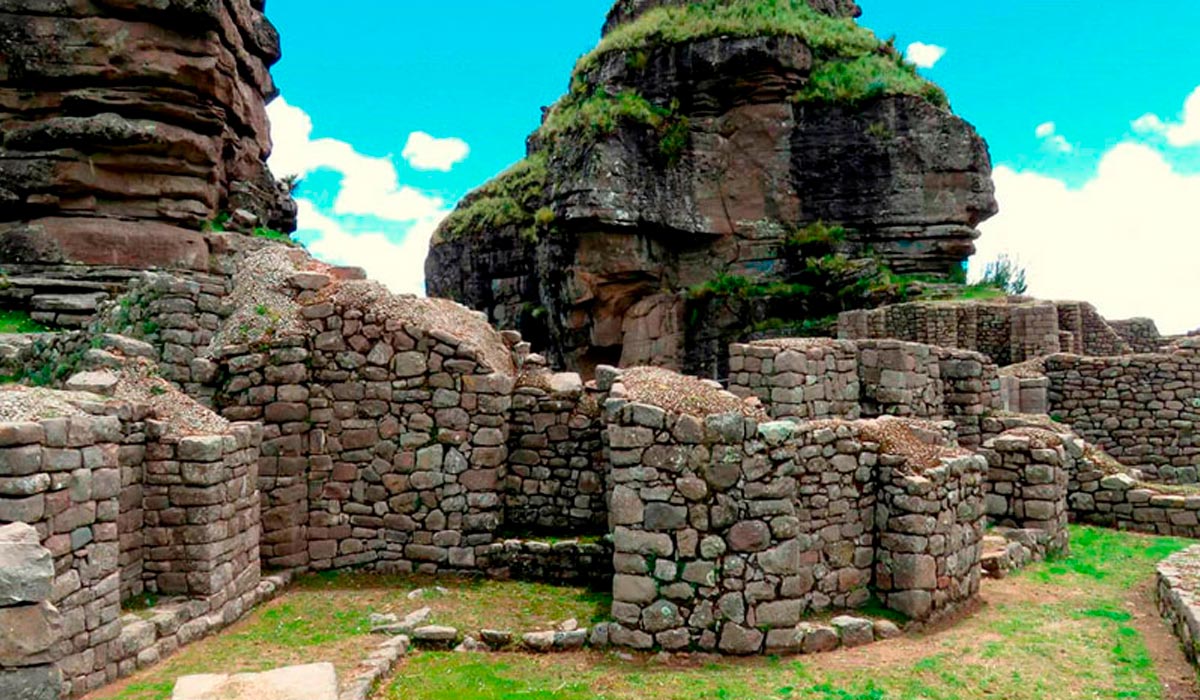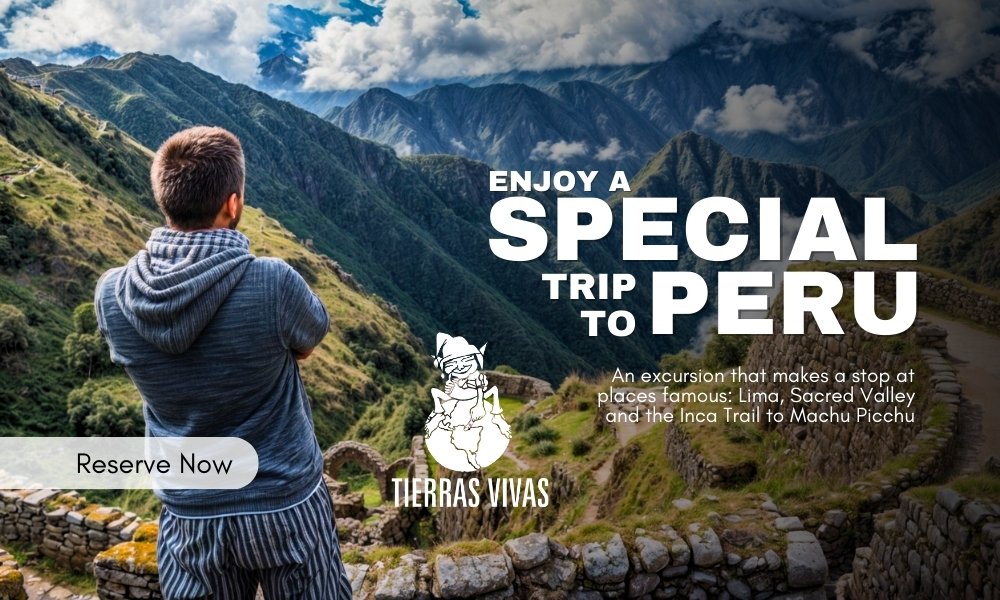Waqrapukara stands as one of the most striking but least explored archaeological treasures in the Cusco region. Located in the province of Acomayo, this complex sits on the edge of an abyss over the Apurímac River canyon, at an altitude of 4,300 meters above sea level. Its most distinctive feature is the natural geological formation on which it was built, two impressive rock peaks that dominate the landscape and give it its name.
Etymologically, the name comes from the Quechua words Waqra (horn) and Pukara (fortress), translating as "Horn-shaped Fortress". However, for the local people of Acos, the interpretation is different; they know it as Llamapukara, claiming that the peaks represent the ears of a llama on alert. Beyond its shape, the site is an example of the "architecture of power", with carved stone walls, terraces, and ceremonial rooms that suggest its function as a top political and religious sanctuary.
Unlike traditional tourist circuits, Waqrapukara is a destination reserved for adventure tourism. Getting here requires physical effort and determination, as it involves hiking through the Andean puna. This guide will detail the access routes, the difficulty of the trek, and the logistics needed to conquer this fortress.
Location
The Waqrapukara Archaeological Complex is located in the district of Acos, belonging to the province of Acomayo, in the department of Cusco. Geographically, the site stands on a rock formation on the right bank of the Apurimac River, overlooking one of the deepest and most spectacular canyons in the region.
Etymology or meaning of his name
The denomination, Waqrapukara, seems to be in current use as it is translated as fortress of the horns, making a clear allusion to the horns of cattle that are of recent presence in the area, in addition, there is perhaps a previous denomination among the population, LlamaPukara, which would translate as llama fortress, which would reveal a much more coherent analogy with the local culture, there is also the name Llaqtapukara which would translate as "people's barracks", which perhaps alludes to the place, ultimately refuge of the resistance that the Qanchis people opposed to the Inca empire and finally we can quote the Archaeologist Miguel Cornejo who, beyond a linguistic interpretation, indicates that the place represents "the architecture of Power".
History
The archaeological site of Waqrapukara has been a place of religious and administrative importance throughout various stages of human occupation, long before the consolidation of the Inca empire.
-
Pre-Inca Occupation: The Qanchi Ethnicity
Archaeological research suggests that the first occupants of the area were the Qanchi ethnic group. During this period, the site already worked as a very important sanctuary dedicated to the creator god Teqsi Pachacamaq Wiraqocha. Later, as part of the expansion plans of the Tahuantinsuyo, the Incas conquered this territory. Due to its strategic location dominating the canyon, the Incas reused the place, giving it an administrative and military function without removing its ancestral religious character. -
The Rebellion of Ttito Qosñipa
One of the most fascinating episodes of its history, told in chronicles and oral traditions, happened during the government of the Inca Huayna Cápac. The local leader of the Qanchis, Ttito Qosñipa, organized a rebellion against the Inca state due to the increase in textile tributes. After resisting the imperial troops, he took refuge in Waqrapukara, turning it into his stronghold. It is believed that it was during this siege when the characteristic towers were built or reinforced to serve as watch and defense posts. -
Political Resolution and Current Status
The history ends with an example of Inca diplomacy. Instead of executing the rebel after his eventual surrender, the Inca chose a political alliance. Ttito Qosñipa received a ñusta (Inca princess) as a wife and was incorporated into the imperial army, later participating in the conquest campaigns towards present-day Ecuador. As a result of this pact, Waqrapukara was raised to the status of official Inca Sanctuary of Sun worship.
In recognition of its historical and architectural value, the site was declared Cultural Heritage of the Nation by the Ministry of Culture on July 17, 2017.
Climate and Temperature:
The climate of the place corresponds to that of the entire Cusco region with the two respective seasons that between May and October are in the cold-dry period and between the months of November and April in the rainy season, on the other hand, the winds can be constant and increase between the months of August and September due to the geography of the place.
Finally, temperatures can have a maximum of 19 degrees Celsius and a minimum of -6 degrees on the coldest and harshest nights.
How to get to Waqrapukara?
At the moment there is no public transport that reaches the walking points, it is advisable to go in a private vehicle or hire a tour.
-
Arrive by Sangarará (short route)
Depart from Cusco in private mobility to the District of Sangarará. Then take the detour until you reach Punta Carretera. Here begins the 8 km walk to reach Waqrapukara, the duration of the walk is 2 hours and 30 minutes one way and the return is approximately 3 hours and 30 minutes. -
Arriving through the Community of Huayqui
Waqrapukara can be reached from Acomayo following the Huáscar branch that goes to the peasant community of Huayqui. It is a bridle path of approximately 7.5 kilometers. -
Getting through Saint Lucia
From Cusco to the detour to Acomayo (buses and buses that go to Sicuani), from here by taxi or bus to Pomacanchi. To go to Saint Lucia it is recommended to rent a vehicle (public service is scarce).
Difficulty
The difficulty it has would be medium to high. The walk is usually long and uphill, so people who are not in good physical condition may have some problems going up.
However, it is worth the effort, since the views are truly spectacular; and throughout the journey you can appreciate the various natural beauties. If you take the route through Sangarará on the way, you will appreciate Vicuñas in its natural area.
Tours to Waqrapukara
Tours to Waqrapukara for 1 day have a cost that varies from 60 to 80 dollars. They include everything you need for the trip: complete transportation, lunch, entrance fee, tour guide and utensils for the walk. You can hire a tour with the tourism agency of your choice.
The 2-day Waqrapukara tours include a night camping next to the Inca archaeological site. Prices range from 140 to 200 dollars per person. Includes: full transportation, food (breakfast, lunch and dinner), entrance fee, tour guide and utensils for the walk. Prices vary depending on the tourism agency you choose.
Can I go on my own?
Waqrapukara is also a destination that can be visited on your own. To do this, you must take public transport to Cusipata (located on Huayruropata avenue in the city of Cusco). Once there you must take another public transport to the town of Sangarará. There begins the walk to the Inca archaeological site. The return trip takes the same return route.
More information
- From the top of Waqrapukara the winds are strong. The temperature during the day can reach 23ºC. while at night the cold can drop to 0ºC. During the visit, it is best to wear a windbreaker jacket, comfortable pants and shoes, as well as a poncho in case of rain.
- The walk that leads to Waqrapukara follows ancient routes built by the Incas (the famous qhapac ñan or Inca road network). Some researchers suggest that the route there was a pilgrimage. There are still many mysteries to unveil in Waqrapukara.
- The best time to visit Waqrapukara is during the months with little rain (from May to October). The rest of the year, especially January, February and March, the constant rains can prevent a comfortable walk there.
A few other recommendations for an awesome experience.
- Wear suitable walking shoes, or at least thick-soled sneakers.
- Do warm-up exercises prior to the start of the walk, this will prevent possible muscle contractures.
- Take into account the weather that is prevailing at the time in which you carry out the activity.
- Take into account that it is preferable to leave this activity for days after your arrival.
- We recommend acclimatizing, which implies that you monitor the effects that altitude produces on you from the first moment you set foot on Cusco soil.
- Take something extra to eat, water and some dried fruit, they will be the best response to your physical needs.
- Bring a change of clothes to use at the end of the activity.
- Warm and light and warm clothing.
- Use trekking poles, they help a lot with the physical effort.
- Don't stop using sunscreen.
- Do not drink alcohol the day before the activity.
Other activities you can do
-
Waqrapukara Festival
The Waqrapukara festival is a cultural activity promoted every year by the local government of the Acos district, this in order to promote the folkloric gathering and the cultural revaluation of the archaeological landscape of Waqrapukara. The activities consist of the staging of the already legendary Qanchis resistance against the Inca Wayna Qapaq, which is divided into 4 acts that are followed by around 15 typical dances of the region, which brighten up the festivities in progress.
This activity is carried out in the month of August, being a perfect date for a visit to the place. -
Mountain biking
With a scheduled activity on a properly designed route, it is possible to cycle as part of the activities in the direction of the Waqrapukara archaeological center. -
Kayaking
In the calm lagoons surrounding the route towards Waqrapukara it is possible to practice kayaking as a complementary activity. -
ATVs
It can be done as a complementary activity and as part of the route to the attraction.
Best Trekking and Tours in Peru
Many are the routes that take you to Machu Picchu, but none is like the Inca Trail Tours, the most famous pedestrian path in the Americas. After flying from the capital of Peru, Lima, you will arrive in Cusco to walk for four days along a path through forests and dense fog, millenary stone steps and discovering the ruins of ancient fortifications and Inca cities, and all the time enjoying majestic views.
- Sacred Valley Bike Tour
- Honeymoon in Machu Picchu
- 1 Day Inca Trail Hike to Machu Picchu
- Sacred Valley Tours
- Lares Trek to Machu Picchu 4 Days
- Huchuy Qosqo Trek to Machu Picchu
- Short 2 Day Inca Trail Hike to Machu Picchu
- 2 Day Inca Trail with Camping
- Apu Ausangate Trek 7 days
- 4 Day Jungle Trek to Machu Picchu
- Inca Quarry Trail to Machu Picchu
- Urubamba River Rafting
- 5 Days Salkantay Mountain Trek
- 3 Days Salkantay Trek to Machu Picchu
- Huchuy Qosqo Trek to Machu Picchu
- 7 Lakes Ausangate Trek
If you want to visit Machu Picchu, we recommend you to book your Machu Picchu Ticket in advance, so you will enjoy your Vacation in Machu Picchu without any problem.










